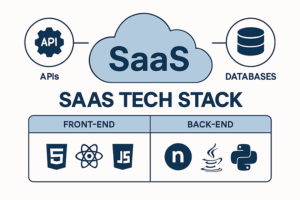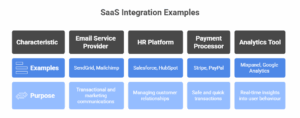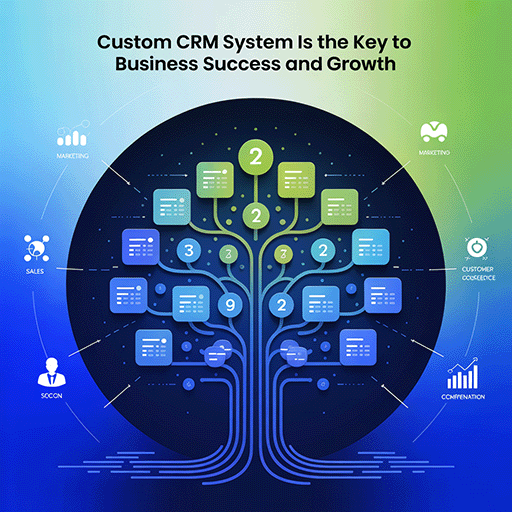One of the most important strategic choices a company can make nowadays is selecting the appropriate SaaS tech stack. The underlying technology directly impacts performance, user experience, and your capacity to expand effectively, whether you’re developing a new SaaS product or scaling an already-existing platform. To provide dependability, speed, and flexibility, every component of your stack—from frontend frameworks to cloud infrastructure—must cooperate.
The key elements of a contemporary SaaS technology stack will be dissected in this guide, along with well-known combinations like the MEAN and JAMstack, and practical advice on how companies can organise their stacks for optimal operational impact.
What Is a SaaS Tech Stack?

The set of tools, frameworks, programming languages, and infrastructure needed to create and manage a Software as a Service (SaaS) application is known as a SaaS tech stack. SaaS platforms, in contrast to conventional software that is installed locally, are hosted in the cloud and accessed through web browsers. As such, they necessitate reliable APIs, cloud services, and a smooth transition between frontend and backend systems.
A typical tech stack for SaaS consists of the following layers:
- Frontend (Client-side)
- Backend (Server-side)
- Database
- Cloud infrastructure & DevOps tools
- APIs & third-party integrations
- Security and monitoring solutions
The complexity, scalability requirements, user base, and budget of your product all play a role in selecting the best tech stack for SaaS applications.
Learn more: SaaS Application Development – Complete Guide
Key Components of a SaaS Software Stack
A few essential components must be present in your tech stack in order to create a scalable, high-performing SaaS platform. The essential elements that make up a dependable SaaS application are broken down as follows:
Frontend Technologies
Users interact with the dashboards, reports, settings, and all other elements that make up the frontend. Performance and responsiveness are critical for SaaS platforms.
Among the widely used frontend frameworks are:
- React: Highly scalable, supported by Facebook, and ideal for dynamic UIs
- Vue.js: Lightweight and beginner-friendly
- Angular: Backed by Google, great for enterprise-level applications
Using JavaScript, APIs, and Markup, the JAMstack architecture is also becoming more and more popular for creating frontend experiences that are safe and quick to load.
Backend Technologies
Payments, user authentication, API integrations, and application logic are all managed by the backend. The frontend is powered by this engine, which also connects to the database and outside services.
Typical backend stacks and frameworks consist of:
- Node.js (used in MEAN/MERN stacks)
- Python + Django
- Ruby on Rails
- PHP (LAMP Stack)
- Java Spring Boot
A serverless stack with Google Cloud Functions or AWS Lambda is also a good option for contemporary, event-driven SaaS products.
Databases
Your SaaS technology stack isn’t complete without robust data storage. Choosing between relational (SQL) and non-relational (NoSQL) databases depends on your app’s data structure.
- PostgreSQL: Great for structured data and complex queries
- MySQL: A classic choice for LAMP-based stacks
- MongoDB: Flexible NoSQL database used in the MEAN and MERN stacks
- Firebase: Popular for real-time apps and serverless architectures
Want to see a real implementation? Check out our guide to SaaS Product Development
Cloud Infrastructure & DevOps
In SaaS, scalability and uptime are crucial. Platform-as-a-service (PaaS) and infrastructure-as-a-service (IaaS) solutions are offered by cloud platforms such as AWS, Google Cloud, and Azure.
Important hosting and DevOps tools:
- Docker: Containerizes your application
- Kubernetes: Orchestrates containers at scale
- CI/CD Pipelines: Automates testing and deployment
- Terraform: Manages infrastructure as code
Load balancers, caching tools (like Redis), and monitoring tools (like Prometheus or Datadog) should also be part of your SaaS platform tech stack.
API Integrations
SaaS apps nowadays hardly ever operate alone. Whether it’s for data analysis, marketing, billing, or communication, today’s users expect software that easily integrates with the tools they already use. Your SaaS tech stack should therefore be built to facilitate scalable and easy integration with a variety of third-party APIs. These might include email service providers like SendGrid or Mailchimp for transactional and marketing communications, HR platforms like Salesforce or HubSpot for managing customer relationships, payment processors like Stripe or PayPal for safe and quick transactions, and analytics tools like Mixpanel or Google Analytics for real-time insights into user behaviour and performance metrics.

By integrating these services, you can improve your feature set, automate processes, and provide end users with a more seamless experience. Your backend must be able to handle API requests and responses effectively to support these integrations. Using GraphQL or RESTful APIs guarantees that your SaaS application can efficiently and reliably consume data or services from other sources as well as expose its functionality to external systems. Maintaining a competitive edge in a market that is changing quickly, scaling your app, and facilitating ecosystem partnerships all depend on this degree of flexibility.
Security & Monitoring
In today’s SaaS ecosystem, cybersecurity and system monitoring are essential. Put in place automated backups, role-based access controls, compliance procedures (such as GDPR or HIPAA), and data encryption (both in transit and at rest).
Tools for security to think about:
- Auth0 or Firebase Auth for authentication
- SSL/TLS protocols for secure data transmission
- Vulnerability scanning and penetration testing
Common SaaS Tech Stack Combinations
Depending on their objectives, various businesses need different stacks. Some of the most well-liked combinations in the SaaS sector right now are listed below.
1. MERN Stack
MongoDB + Express.js + React + Node.js
For creating dynamic, high-performance SaaS platforms, a complete JavaScript stack is perfect. It enables quick development and is lightweight and flexible.
2. MEAN Stack
MongoDB + Express.js + Angular + Node.js
Enterprise-grade SaaS applications that demand intricate workflows, modular design, and long-term maintainability are especially well-suited for Angular since it gives your frontend a strong architectural framework. Angular, which is developed and maintained by Google, provides innovative solutions for form validation, dependency injection, state management, and reliable routing—all of which are essential for creating scalable and secure applications. Teams can create and test individual features independently thanks to its component-based architecture, which speeds up development without sacrificing code quality. Furthermore, Angular’s stringent typing with TypeScript improves dependability and lowers runtime errors—two factors that are particularly crucial in applications that handle sensitive data or large user volumes.
3. LAMP Stack
Linux + Apache + MySQL + PHP
For simpler SaaS applications or when utilising CMS tools like WordPress for SaaS-like platforms, this tried-and-true stack works best.
4. Serverless Stack
The serverless stack makes use of cloud-native services such as Amazon S3 for serving static files and storing media assets, DynamoDB for quick and scalable NoSQL data storage, and AWS Lambda for backend logic execution. With this architecture, developers can concentrate solely on writing code, as the cloud provider takes care of provisioning, scaling, and maintenance, removing the need to manage physical servers or even virtual machines. Micro SaaS apps and early-stage startups that want to cut infrastructure expenses, minimise operational overhead, and easily scale with user demand will find it especially perfect. Serverless architecture is a wise option for teams looking to create lean, adaptable, and affordable software solutions without sacrificing performance or dependability because it also facilitates faster deployment cycles, improved fault tolerance, and automatic scaling.
Common SaaS Tech Stack Combinations
| Tech Stack | Components | Best For | Key Characteristics |
| MERN Stack | MongoDB, Express.js, React, Node.js | Dynamic, high-performance SaaS platforms | Full JavaScript stack, rapid development, lightweight, flexible |
| MEAN Stack | MongoDB, Express.js, Angular, Node.js | Enterprise SaaS, complex & scalable applications | Modular design, strong architectural framework, TypeScript support, ideal for apps with sensitive data or large user volumes |
| LAMP Stack | Linux, Apache, MySQL, PHP | Basic SaaS apps, CMS-based SaaS platforms | Classic, proven stack, best for simple solutions or WordPress-based platforms |
| Serverless | AWS Lambda, Amazon S3, DynamoDB, other cloud services | Micro SaaS, startups seeking cost-efficiency | Cloud-native, no server management, automatic scaling, reduced operational overhead, high fault tolerance, fast deployment cycles |
Read more about modern SaaS trends: Top 10 SaaS Trends in 2025
Choosing the Best Tech Stack for SaaS
Aligning technology with business requirements is the key to selecting the best SaaS tech stack.
Begin by responding to the following:
- What is the scale and complexity of your app?
- What are your uptime and scalability requirements?
- How important is real-time performance or serverless scalability?
- What third-party services must integrate seamlessly?
Take team expertise into account as well. The effectiveness with which your developers can create, manage, and expand the system is what makes a great stack, not just the tools.
Why Your SaaS Stack Matters for Business Operations
By facilitating automation, optimising workflows, and guaranteeing a flawless customer experience, the appropriate SaaS technology stack increases operational efficiency. It also affects your ability to quickly update features, change course, and adhere to industry standards.
A modern stack lets you:
- Deploy updates with zero downtime
- Automate billing, user onboarding, and analytics
- Scale globally with cloud-native services
- Ensure security from day one
In the end, this technological underpinning affects profitability, customer retention, and satisfaction.
Conclusion
Optimising your company’s operations requires a cutting-edge, well-designed SaaS tech stack. Every component of your stack, from dependable cloud infrastructure and security tools to scalable backend solutions and user-friendly frontend frameworks, should be selected with your business objectives in mind. The correct set of tools can significantly affect your system performance, long-term scalability, and speed to market, regardless of whether you’re developing a sophisticated enterprise platform or a small, lightweight SaaS application.
Fortunately, LITSLINK has a lot of experience developing custom software. We can also do that for you. Let’s get started—just get in touch with us!





